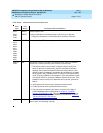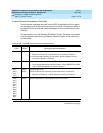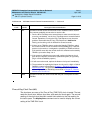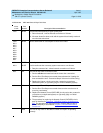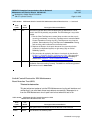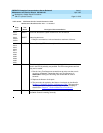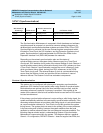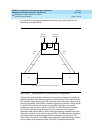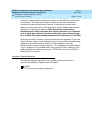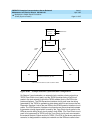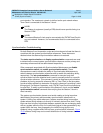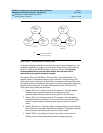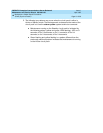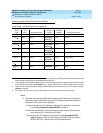
DEFINITY Enterprise Communications Server Release 5
Maintenance and Test for R5vs/si
555-230-123
Issue 1
April 1997
Maintenance Object Repair Procedures
Page 10-1324SYNC (Synchronization)
10
SYNC (Synchronization)
The Synchronization Maintenance is composed of both hardware and software
components and its purpose is to provide a common reference frequency for
reliable digital communication between systems and other PBXs, COs or CPE.
Synchronization is achieved via the use of several system components which
include the Tone-Clock, the DS1 Interface, and the Expansion Interface circuit
packs. Synchronization is achieved between the PPN and the EPNs via the
Expansion Interface Link (EXP-LINK) between the networks.
Depending on the network synchronization plan and the status of
synchronization sources, the system timing reference may be a Tone-Clock
circuit pack, DS1 interface circuit packs or an external Stratum 3 clock. Stratum 4
synchronization extracts timing information directly from a DS1 reference or from
a Tone-Clock. Stratum 3 synchronization requires the use of a Stratum 3 clock
which provides a timing signal, derived from DS1 references, to the TN780
Tone-Clock circuit pack. The external Stratum 3 clock is a more stable timing
source than the Stratum 4 clock and provides 24-hour holdover in case of
reference failures. The Stratum 3 clock has redundant components.
Stratum 4 Synchronization
The system can be configured with primary and secondary synchronization
references (DS1 interface circuit packs) when using Stratum 4 synchronization.
Both references are optional (since the local oscillator can be used), and the
secondary reference is optional if a primary is provided. If this system is the
master for the network, then its local oscillator would be used and no DS1s would
be used as references.
If the primary synchronization reference is not providing a valid timing signal, the
system automatically switches to the secondary synchronization reference. If the
secondary reference does not provide a valid timing signal or is not administered
as a synchronization reference, a Tone-Clock circuit pack provides the system
timing source. The system does not revert to the primary if the current reference
is the secondary and is failing; however the system switches from the local
oscillator to another reference when the new reference becomes available. The
following diagram should assist in understanding Stratum 4 Synchronization
Maintenance components within the system. This diagram depicts a possible
Generic 1.2 configuration; DEFINITY Generic 1 does not support two EPNs, but
MO Name (in
Alarm Log) Alarm Level
Initial Command to
Run Full Name of MO
SYNC MAJOR display errors Synchronization Maintenance
SYNC MINOR display errors Synchronization Maintenance
SYNC WARNING test synchronization Synchronization Maintenance




